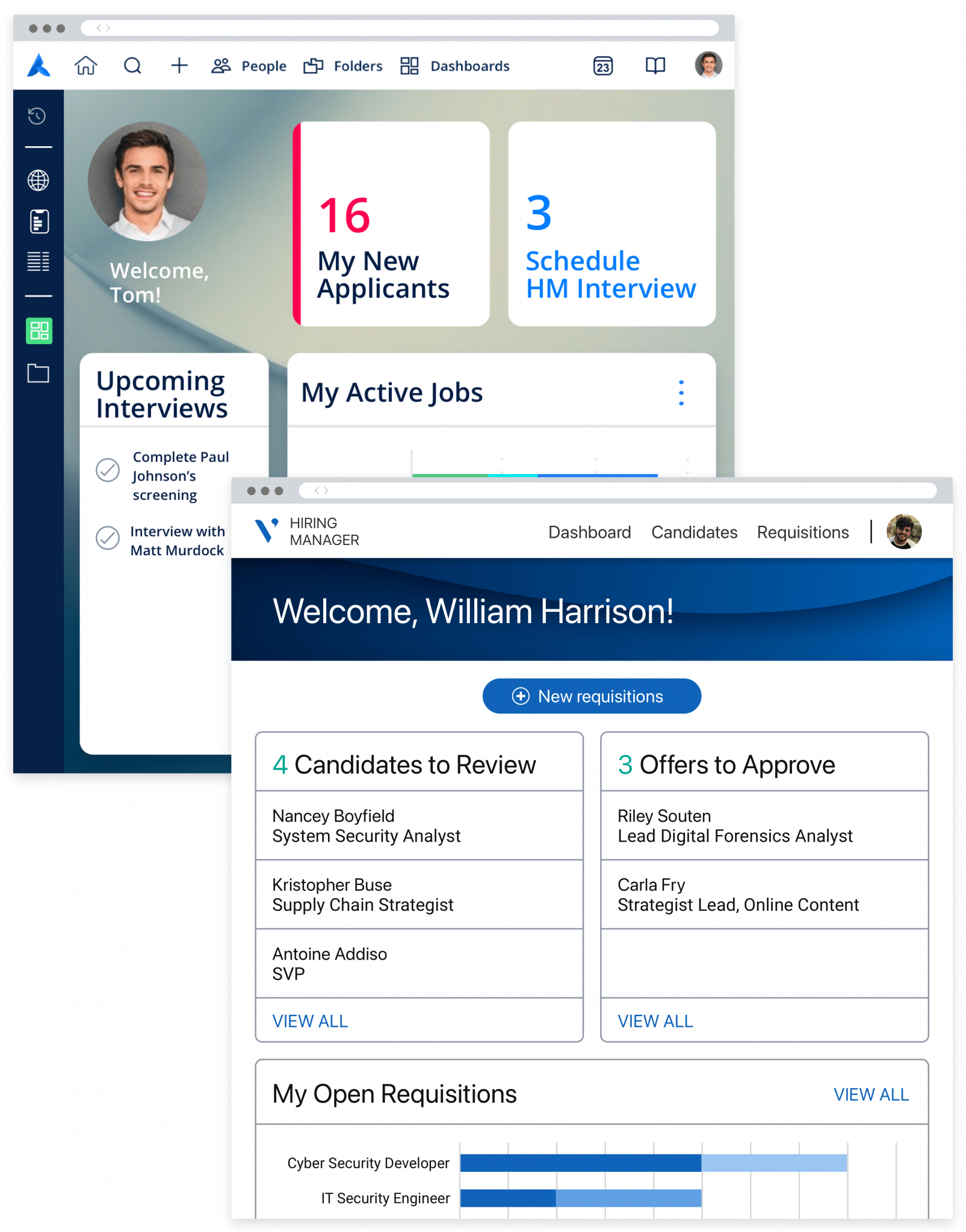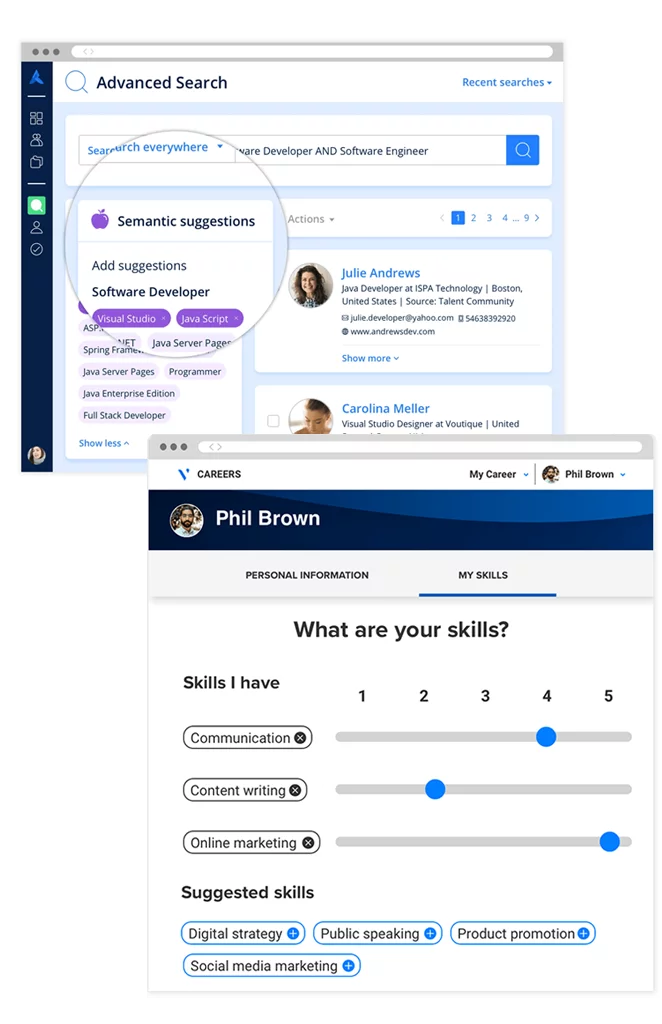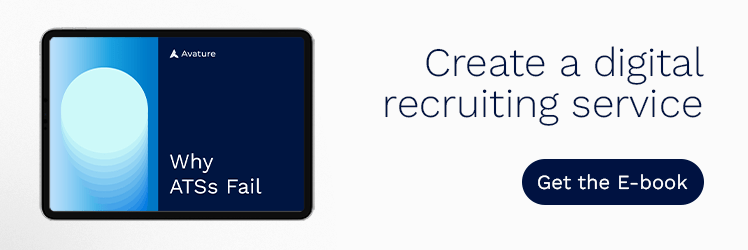If you struggle to keep up with the rising demands of modern recruitment, you’re not alone. Nearly 98 percent of Fortune 500 companies rely on an applicant tracking system (ATS) to streamline increasingly complex hiring processes and get ahead of the competition.
But what makes these systems so indispensable, and how can they benefit your organization?
Read on to discover the key features and benefits of modern ATS technology and learn how it can transform your recruitment process. Plus, receive a comprehensive guide to help you select the best ATS solution for your unique hiring needs.
What is an ATS?
An Applicant Tracking System (ATS) is a dynamic software solution designed to consolidate and support a company’s recruiting operations.
Serving as the central hub for all job openings and applications, an ATS act as the one-stop-shop for the entire recruitment process. By tracking candidates from their initial application to the final hiring stage, an ATS empowers recruiters to identify and engage top talent with unparalleled efficiency.
Key Features of Modern ATS Solutions
Some of the features offered by contemporary state-of-the-art ATS software include:
- Career Site Optimization (CSO)
- Screening automation
- Interview scheduling
- Branded emails and branded career sites
- SMS capabilities
- Resume parsing
- References and background check automation
- Artificial Intelligence (AI)
- Tools to improve collaboration
What’s the Difference Between an ATS and a CRM?
A Recruitment Candidate Relationship Management (CRM) system is software that manages and nurtures long-term relationships with potential candidates through recruitment marketing.
Unlike an ATS, which focuses on managing applicants and the hiring process, a CRM is all about proactive recruitment.
Taking its cue from how marketers identify and target leads, it helps recruiters build and maintain a talent pool of qualified candidates, automate communication and collaborate effectively with team members, fostering long-term engagement through personalized communication.
Ultimately, both serve to improve engaging and hiring talent, via different complementary approaches.
Increasingly, talent acquisition teams are adopting both a CRM system and an ATS, and are leaning towards solutions that combine the two into a single integrated platform. This way they can track and nurture relationships with candidates throughout the recruitment cycle.

Benefits of Applicant Tracking Systems for Recruiters, Employers and Candidates
An applicant tracking system is a transformative tool that delivers significant benefits to recruiters, employers, and candidates alike.
For enterprise-level organizations, an ATS addresses unique challenges, such as managing high volumes of applications, ensuring compliance with complex regulations, and optimizing the entire recruitment process.
Enhance Efficiency and Reduce Workload
Recruiters spend an average of 24 hours per hire screening a large pool of candidates, many of whom fail to meet the basic requirements. ATS software can speed up the screening process by automating routine tasks, like parsing resumes, generating pre-populated emails, and creating automated job workflows.
This automation significantly reduces the time spent on manual tasks throughout the hiring cycle, including job posting, candidate communication, and interview scheduling.
It also minimizes the reliance on burdensome, paper-based methods and helps to prevent qualified candidates from slipping through the cracks.
Moreover, automation helps eliminate mistakes and delays, moving applicants swiftly through the hiring funnel and improving cost-to-hire metrics. By streamlining these processes, an ATS allows recruiters to spend more time engaging with qualified candidates and focus on more value-added activities.
What’s more, an ATS enhances the candidate experience by simplifying the application process. Candidates can upload their resumes and autofill application forms, reducing the time and effort required to apply for a job.
Many systems also allow job seekers to save their profiles, enabling them to swiftly apply for multiple positions within the same organization.
Reduce Bias and Ensure Compliance
Overcoming hiring bias is a significant challenge for enterprise-level organizations. An ATS promotes fairness and objectivity in hiring by standardizing how applications are reviewed.
Using predefined criteria to assess candidates, an ATS reduces the potential for human bias, ensuring all applicants are evaluated based on their qualifications, acquired skills and suitability for the role.
This objective approach encourages a more inclusive and merit-based recruitment process, giving all candidates a fair chance of being considered for positions.
Aside from reducing bias, an ATS solution is crucial for protecting candidate privacy. Sharing emails with attached resumes is simply too risky nowadays and forbidden in many legislations worldwide.
An ATS overcomes this challenge by enabling the secure sharing of data with appropriate stakeholders, ensuring that all information is handled in compliance with regulatory requirements.
Handle High-Volume Applications
Receiving a flood of job applications—sometimes millions per year—is a common challenge for enterprise-level organizations. Manually reviewing each one is simply not feasible. This is where an ATS comes into its own.
By automating the initial screening process, an ATS efficiently filters out unqualified candidates, enabling recruiters to zero in on top talent. For example, by introducing automated knock-out questions, Wayfair was able to revolutionize its high volume recruitment, filtering out a third of all applicants and contributing to an 88% reduction in time spent in the application review stage.
This automation streamlines the process and ensures timely responses to all job seekers, a crucial factor since 52 percent of job seekers cite the lack of employer feedback as the most frustrating part of their job search.
Features You Should Look for in an Applicant Tracking System
When it comes to applicant tracking systems, one size does not fit all. Selecting the right ATS involves considering a myriad of factors, from the size and type of your organization to your specific hiring needs and goals.
1. Scalability
Scalability is key, especially for high-growth and large organizations. It’s not just about handling a large number of users; it’s about maintaining top performance under a variety of load conditions.
Look for an ATS solution that excels in complex tasks like indexing, searching, filtering, and generating reports quickly and efficiently. This ensures a smooth, responsive user experience, no matter the scale.
A truly scalable ATS should also respond to the diverse needs of a global enterprise. This includes support for different languages, time zones, and data access permissions. Ensure the system’s reporting module recognizes user-specific time zones and allows for efficient navigation of large datasets.
Vendors with experience in scaling usability to enterprise level will be equipped to tackle common challenges and provide solutions for a large, varied user base. This way, everyone in your organization can use the system effectively, regardless of their location or role.
2. Powered by Explainable AI
As AI becomes increasingly prevalent in talent acquisition software, transparency is essential. Explainable AI, is therefore key to supporting clear and understandable decision-making processes. After all, AI should only inform decisions, not make them alone.
With this in mind, it’s essential that ATS software provides insights into AI operations, allowing you to adjust parameters and understand the criteria used in candidate evaluations and beyond.

3. Personalized Experiences
Today’s candidates expect a seamless, user-friendly experience akin to what they find on top e-commerce sites.
To deliver the consumer-grade experience jobseekers expect, an ATS should offer a modern career site with personalized job recommendations based on candidates’ interests and skills—a must-have for larger companies with numerous job openings.
The career site should also allow candidates to create profiles, check application statuses, and manage their data, providing a self-service experience that boosts engagement and satisfaction.
4. Enhanced Security and Compliance
As the need for regulation surrounding user privacy increases, ,securing candidate data is paramount. Robust data protection features, including encryption, secure access controls, and compliance with global data privacy laws are therefore essential in any ATS solution.
By protecting sensitive candidate information, an ATS can build trust with candidates, increasing their confidence in your employer brand and ability to safely handle their job applications, and protect your own company from legal jeopardy and reputational damage.
5. Configurability
The talent landscape is in constant movement, and the ability to adapt your approach to meet emerging challenges and opportunites is crucial.
Whether it’s tailoring your processes to meet the expectations of Gen Z, discovering the benefits of AI, or embracing a skills-based approach to help uncover hidden gems, a company that fails to move with the times is a company that fails, period.
Having an ATS configurable enough to evolve in sync with your strategy means you’ll be equipped to meet the challenges of today and tomorrow.
How to Choose the Best Applicant Tracking System for Your Organization?
Choosing the best applicant tracking software for your organization involves considering various critical factors, such as scalability to accommodate your organization’s size, robust security and compliance features to protect candidate data, and the ability to deliver personalized and explainable AI-driven experiences.
To learn more about contemporary ATS software, check out our “Why ATSs Fail” e-book and discover how top HR leaders are modernizing their recruiting services. Plus discover strategic insights and practical tips for choosing the right system, writing effective RFPs, and navigating vendor roadmaps.
Or, better yet, book a demo today and learn how Avature’s applicant tracking solution can help you enhance your recruitment processes.



